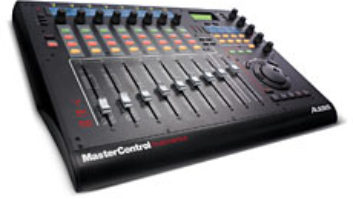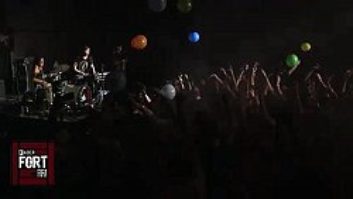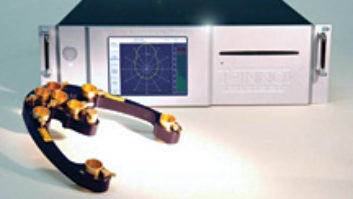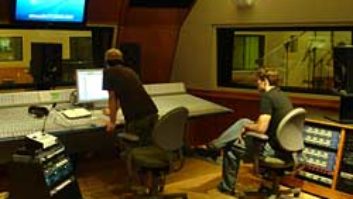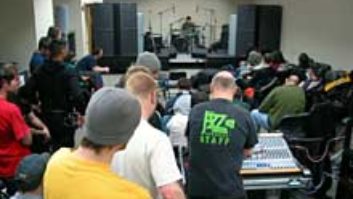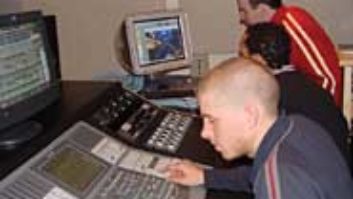It’s been almost two years since the first modular, 24-bit/24-track hard disk recorders were introduced to the pro audio world. The Alesis ADAT HD24 ($2,499 list) follows the lead of previously released Tascam and Mackie models, and incorporates tape recorder-style transport control buttons into its front panel user interface. But unlike the competition, the HD24 takes tape recorder emulation one step further by writing its 24 tracks to its removable hard disks in linear fashion. This type of formatting, which Alesis dubs ADAT FST™, has both its advantages and disadvantages.
Because ADAT FST writes a song’s tracks to adjacent sectors of its hard disk, fragmentation and seek time are greatly reduced. This allows reliable read/write operations using common 5,400 rpm IDE drives, which cost less in dollars-per-gigabyte than the VHS tapes used in earlier 16- and 20-bit ADATs. The price advantage of using 5,400 rpm drives over faster drives will diminish over time as the cost of all drives continues to fall. However, reduced fragmentation is always a good thing.
The downside of ADAT FST formatting is that it doesn’t allow multiple track takes or a Record/Undo function, which competing hard disk recorders offer. When you punch in on an HD24 track, any pre-existing material on that track at that point in the song is irretrievably erased (written over), just as it would be on a tape-based ADAT.
In simple terms, the HD24 is a 24-bit/96kHz ADAT in hard disk clothing. But there’s a lot more to this story. Let’s take a closer look at what makes the HD24 spin.
LAYOUT AND DISPLAY
The HD24’s control and display layout are very user friendly and intuitive. Looking at the unit’s front panel, all meters and track-arming buttons are located on the left side and directly above two hot swappable drive bays. Buttons for setting metering and monitoring options lie immediately to the right of the meters. The bottom-right portion of the front panel are buttons that provide transport control, as well as access to editing functions, MIDI and other utility settings, and digital sync, sample rate and audio input (analog or digital) source settings. Familiar up/down and left/right cursor buttons are also provided here to adjust parameter values and to help you navigate the informative alphanumeric display, which resides in the top-right portion of the front panel. The display provides an absolute-time readout in hours, minutes, seconds and frames; shows which drive is currently selected and how much recording time remains available at the current sample rate; and indicates the values of a host of other parameters. Four other buttons located in the front panel’s far-right corner let you create, name, select and delete songs.
The HD24 ships with two custom-engineered drive caddies, each of which can theoretically accept drives up to 2,000 GB in size (though drives that size don’t currently exist in the HD24’s 3.5-inch tray configuration) and from most any manufacturer. One of the caddies comes loaded with a removable 20-gigabyte hard drive (you’ll need to buy another hard drive for the second caddy), which allows you roughly 90 minutes of 24-bit/48kHz linear-PCM recording time on 24 tracks. Thankfully, the HD24 does not use data compression.
Of course, you can only record on one drive at a time, but you can back up all or part of one drive’s contents to the other using a Utility menu accessed from the unit’s front panel. It only takes a few minutes to back up an entire drive in this manner. And back up you should; although I found that the HD24 was extremely reliable, there was one isolated instance when two bars of music on one track suddenly and mysteriously disappeared. To further safeguard your data, you should always use the front panel “soft” power switch to park the drive heads before removing power with the rear panel “hard” power switch.
Each of the HD24’s tracks has its own track-arming button and 10-segment, tri-colored LED ladder meter — +4 dBu is factory-calibrated to -15 dBFS. You can switch the meters from normal ballistics to momentary or continuous peak-hold mode. The dedicated peak-clear button is handy. The HD24 uses the “all input” (all tracks receive source inputs) and “auto input” (used for punching in/out) monitoring modes familiar to ADAT users. You can’t punch in using the track-arming buttons; tracks must already be in record-ready status before you press Record.
The Rewind, Fast Forward, Stop, Play and Record transport buttons are self-explanatory, with a few notable exceptions. Each tap of the Fast Forward or Rewind button skips the song (in either stop or play mode) five seconds forward or backward in time. Holding the Stop button together with Rewind or Fast Forward causes the HD24 to scrub audio, at first slowly and then at an increasingly faster (and arbitrary) rate the longer you hold the buttons. You can limit your scrubbing to select tracks if you don’t want to hear the whole enchilada.
You can store, edit and select up to 24 locate points in each of the HD24’s 64 possible songs, and the unit provides instant access to six of these points via dedicated front panel buttons. Along with the “locate 0” point provided for each song (all songs start at 00:00:00:00), there is a total of 1,600 locate points. By the way, you can edit the “locate 0” point to create an offset, useful for synching the HD24 with tape-based ADATs. Locate points can be used with Auto Return, Auto Record, Auto Play and Rehearse buttons to perform loop recording/playback and rehearsed auto-punches. You can name 20 of the 24 locate points for each song; the remaining four are dedicated to punch-in/out and region start/end points (the latter for cut/copy/paste editing, which I’ll discuss shortly).
A front panel Track Slip button allows you to slide entire tracks forward or backward in time up to 170 ms, in as little as ¼ms increments, which is useful for aligning the phase of different sources. A MIDI button gives you access to a number of MIDI functions (more on that below).
YOU SAY YOU WANT A RESOLUTION
The HD24’s stock analog I/O can operate at 44.1- or 48kHz sampling rate, courtesy of 24-bit, 128x over-sampling converters. An optional high-resolution board, available for $1,249, allows 88.2- and 96kHz analog I/O as well. A Pitch button lets you varispeed the HD24’s internal clock as much as -300/+100 cents at 48/96kHz nominal settings or ±200 cents at 44.1/88.2 kHz.
You can also slave a stock HD24 (via its rear panel wordclock input) to an external high-res clock source (such as a converter) to enable digital I/O at 88.2/96 kHz. The HD24 can only record 12 tracks max at 88.2/96 kHz, so you lose half your track count when you record at these higher sampling rates. The HD24 recognizes a user bit in the ADAT optical subcode that identifies high-sample rate signals as such, and splits each high-res track between two Lightpipe channels (i.e., track 1 uses channels 1 and 2, track 2 uses channels 3 and 4, and so on). Older Lightpipe-equipped devices such as digital mixers that can’t function at 88.2 or 96 kHz simply treat the two channels as separate but identical-sounding 44.1- or 48kHz signals, respectively.
SLICE AND DICE
The HD24 allows simple cut, copy and paste operations between any tracks and across songs. Region start and end points can be captured on-the-fly and edited to 1/100-frame resolution, which is more than adequate for most simple edits. The HD24 automatically applies crossfades across edit points, and they sound very smooth as long as your edit points are chosen wisely. Before committing to your edit points, you can preview the first five seconds of audio after the edit start point, the last five seconds before the edit end point or all of the audio within the selected region. I liked the ability to immediately tweak these edit points during preview playback, instead of having to wait for playback to cease. The HD24 allows 99 levels of undo for cut, copy and paste operations, but you cannot undo punch-ins and song deletions.
The HD24 doesn’t provide any graphic waveform display or connections for an external monitor for editing purposes. You’ll need to rely on your ears and a little trial and error to get edits to sound perfect. Simple edits are a snap to accomplish. More complex arrangement tweaks, such as staggered edit points across multiple tracks (e.g., to avoid cutting off ringing cymbals), would be mind-boggling to attempt on the HD24 and are better left to a DAW to perform.
The HD24’s rear panel features a generous allotment of ready-to-rock audio I/O, distinguishing the unit from competing models that require expensive add-ons and/or custom cabling. There is a balanced ¼-inch TRS jack for every analog input and output (48 total), and these can also be used with unbalanced signals and tip-sleeve phone plugs without wiring modifications or signal loss — plug and play! A programmable input-normaling function takes analog signals routed to lower-numbered tracks and mults them to higher-numbered tracks as well, saving you the hassle of repatching during later overdubs. Six ADAT Lightpipe connectors provide 24 channels of digital I/O.
Also on the rear panel is the air outlet for the HD24’s built-in fan. The fan noise is a bit distracting, but not noisy enough that I felt it interfered with critical mixdown decisions with the unit mounted in a rack three feet away from me. (However, consider that the backs of my racks face Fiberglas wall panels that absorb high-frequency ambient noise.) The rackmountable HD24 takes up three rackspaces.
The unit’s rear panel MIDI In and Out connectors are used to send MTC and send/receive MMC and software updates. The HD24 worked well as an MTC master (30 fps only) for timecode feed to my 02RV2 at mixdown, with the caveat that the 02R generally seems to prefer slaving to SMPTE. Note that the HD24 cannot slave to MTC.
The HD24’s ADAT 9-pin sync in and out connectors allow you to sync up to five HD24s for a total of 120 tracks, or you can use them to sync the HD24 to tape-based ADATs and/or an Alesis BRC remote. I was also able to perform sample-accurate transfers to and from Digital Performer using the HD24’s 9-pin sync connectors. Because the HD24 does not provide SMPTE I/O, the 9-pin sync input also comes in handy as an avenue to receive timecode from a device such as the Alesis BRC or MOTU Digital Timepiece that converts SMPTE to ADAT 9-pin sync.
An all-important wordclock input is also provided on the HD24’s rear panel (on a 75-ohm terminated BNC connector), enabling you to use high-end, multichannel outboard converters to get audio in and out of the unit. You can also sync the HD24 to its fiber-optic inputs, a method inherently more prone to jitter.
Two tip-sleeve phone jacks accept a momentary footswitch (for hands-free punching) and the supplied LRC transport remote-control unit (which is almost identical to the LRC included with Legacy ADATs), respectively. Alesis plans to offer an optional full-function remote ($TBA) sometime later this year. You’ll also find an IEC power receptacle for the supplied 3-prong AC cord, the aforementioned “hard” power switch and an Ethernet jack on the rear panel. The Ethernet jack gives the HD24 cool networking capabilities, which we’ll examine next.
NETWORKING
You can configure the HD24 as a stand-alone FTP server with its own IP address and connect the unit’s Ethernet port to a local computer network (10Base-T systems only) or to a cable modem that’s hooked up to the Internet. With the HD24 connected to your computer, you can transfer tracks in standard .AIFF or .WAV format between the HD24 and your DAW, allowing you to edit tracks in your computer. That’s cool in principle, but digital transfers via the HD24’s fiber-optic I/O are roughly 4x faster than going the Ethernet route. The real story here is that the HD24’s networking capabilities allow you to collaborate with any other HD24 users who have Internet access — download tracks from a friend in another state while you sleep through the night, do some overdubs the next morning and then upload the new tracks back to your friend during an extended lunch break. Project studios can also send finished tracks via e-mail to distant commercial studios for mixdown on virtually any DAW. The Ethernet jack can also be used in lieu of the MIDI In jack to update the HD24’s software.
SYNCHING TO TAPE-BASED ADATS AND BRC
There are several factors to consider when synching your HD24 to tape-based ADATs and the Alesis BRC via the HD24’s rear panel 9-pin sync connectors. First, you’ll always want the HD24 to be the last slave in the chain; placed elsewhere, it would immediately begin playback before downstream tape-based ADATs would have a chance to locate to your chosen playback point. Second, if your Legacy ADATs are playing a song that doesn’t start at 00:00:00:00, then you’ll need to offset the HD24’s “locate-0” point in order to keep all of the tracks across all decks locked to the correct timecode address in relative terms. Third, the BRC cannot control an HD24 that is operating at 88.2- or 96kHz sampling rate. And, finally, you can’t save BRC setup data to the HD24. There are a few more minor compatibility issues, as well. The upshot is that synching with a Legacy ADAT system is clumsy but workable if you have the patience.
NOW I KNOW MY ABCS
I performed an A/B/C test comparing the HD24’s A/D converters to those in my Yamaha 02RV2 mixer and Apogee Rosetta, in all three cases using the Rosetta as wordclock master in order to minimize jitter. The test sources consisted of stereo recordings of acoustic guitar, captured via a spaced pair of DPA 4011 mics routed through a Millennia HV-3 mic pre. The HD24 ADC’s dynamic range spec of 103 dB belies the quality of the converters. Compared to the 02R’s ADCs, the HD24 provided notably superior transient response and high-frequency extension and a wider stereo image. The HD24’s converters also sounded more open in the upper bass and generally flatter across the entire audio spectrum. Understandably, neither set of stock converters could hold a candle to the Rosetta, which sounded markedly warmer and smoother.
Perhaps the HD24’s biggest selling point is that, aside from its useful networking and editing features (which you may choose to ignore) and a few simple hard disk management routines (which you must learn), the unit is as easy to operate as a 24-track tape recorder. And, it costs much less. The AD/DA sounds great for stock converters at this price point, and the comprehensive audio I/O beats the pants off the competition. The unit’s portability makes it a slam-dunk for live recording applications. For those looking for an idiot-proof, stand-alone MDM or a lickety-split recording companion to a computer-based DAW, the HD24 offers an elegant solution at a fire sale price.
Alesis, 12509 Beatrice St., Los Angeles, CA 90066; 310/301-9563, fax 310/306-7194; www.alesis.com.
Michael Cooper is a Mix contributing editor and owner of Michael Cooper Recording in beautiful Sisters, Ore.
